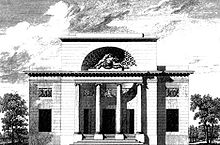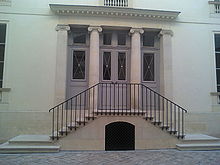- Rue de la Chaussée-d'Antin
-
Coordinates: 48°52′26″N 2°19′58″E / 48.87389°N 2.33278°E
9e ArrtRue de la Chaussée d'AntinArrondissement Located near the metro stations: Chaussée d'Antin - La Fayette or Trinité - d'Estienne d'Orves. The rue de la Chaussée-d'Antin, in the IXe arrondissement of Paris was the street that gave this new quarter of Paris its generic name. It runs north-northwest from the Boulevard des Italiens to the Église de la Sainte-Trinité sited to provide a focal object at its upper end. It has one section of the Galeries Lafayette department store.
Here existed a swampy piece of ground north of the ancient porte Gaillon, one of the city gates built in the wall under Louis XIII. In the 17th century it was still a winding road, the chemin des Porcherons connecting the porte Gaillon to the humble village of Les Porcherons, with a straggling string of raffish premises and an unrailed bridge across the fouled brook of Ménilmontant. The notorious hostelry "La Grande Pinte" stood on the present site of the Église de la Sainte-Trinité. It was graded and resurveyed as a boulevard eight toises in width according to an ordonnance of 4 December 1720, and stretched from the end of rue Louis-le-Grand to rue Saint-Lazare. It received its popular and eventually official name from Louis Antoine de Pardaillan de Gondrin, Duke of Antin (1665–1736), the son of the marquise de Montespan and superintendent of the Bâtiments du Roi, whose hôtel[1] directly faced the opening of the new street; his name became attached to the roadway as early as 1712.
Contents
Notable places
At the junction with the Boulevard des Capucines, site of the former Hotel de Montmorency, then Théâtre du Vaudeville 1869, and Paramount Opéra movies 1927. The main hall was the 'grand salon' of the Hotel in the 18th century. The rotunda on the facade has been kept.
At the junction with the Boulevard des Italiens was the Dépôt des Gardes-françaises (=french gards barracks) built by the colonel Duke of Biron in 1764. It gave the name of the boulevard for some years. On 12 July 1789, a platoon of the gards saved his colonel, M. Duchâtelet, from popular riots. [2]
The higher ground and healthier air, it was thought, to the north and west of the heart of Paris attracted the upper classes in the 18th century. A series of glamorous hôtels particuliers were erected along the Chaussée-d'Antin in the later 18th century (now destroyed) :
- At n°5, hôtel of Madame d'Epinay and the baron Grimm. They were visited by Mozart in 1778. This was also where the street's most famous resident, Frederic Chopin, lived from 1833-1836. Frequent visitors included Franz Liszt.
- At n°9, hôtel of mademoiselle Guimard, who made her reputation as a dancer at the opéra at 600 livres annually, and her fortune as the mistress of the prince de Soubise, was housed in an advanced Neoclassical style, erected for her by Claude-Nicolas Ledoux in 1770-73.
It gained the nickname of "Terpsichore crowned by Apollon temple", by reference to Mlle Guimard (Terpsichore was the Muse of dance). There was a theater with 500 seats. Getting older, Mlle Guimard sold her hôtel with a lottery : she sold 2.500 tickets of 120 pounds.
- At n°20, hôtel of general Moreau where was prepared the coup d'état of 18 Brumaire
In 1977, were found underground 400 pieces of sculptures, from the facade of the cathedral Notre Dame de Paris. Especially heads of the kings of Juda. During the french revolution, the statues were destroyed because people thought that they were statues of kings of France.
- Frederic Chopin lived at no. 38 from 1836-1838, after moving from no. 5 Rue de la Chausee-d'Antin.
- At n°46, hôtel of Mirabeau, where he died on 2 April 1791 after a plentiful dinner. It gaves the Chaussée the Revolutionary name of rue de Mirabeau from 1791 until, with Mirabeau proscribed in 1793, it was renamed rue du Mont-Blanc in celebration of a commune that had been added to French territory. It regained its former name in 1815.
- At n°70, hôtel of Cardinal Fesch, the archbishop of Lyon and uncle of Napoleon.
In the course of the 19th century commercial establishments changed the character of the street, and shops opened in the ground floors of the old residences. For Honoré de Balzac "The heart of Paris today beats between rue de la Chaussée-d'Antin and rue du Faubourg Montmartre." In 1840 the street was extended past rue Neuve-Saint-Augustin. The first one-way streets in Paris were the Rue de Mogador and the Rue de la Chaussée-d'Antin, created on 13 December 1909.
Notes
- ^ Later the hôtel de Richelieu, Paris seat of the duc de Richelieu.
- ^ Le boulevard des Italiens on the web site paris-pittoresque.com
References
- Louis Lurine, ed. 1844 Les rues de Paris. Paris ancien et moderne
External links
- (French) Histoire de Paris rue par rue, maison par maison, Charles Lefeuve, 1875 (http://www.paris-pittoresque.com/rues/288.htm)
- (English) Thirza Vallois, Paris Kiosque: the 9e Arrondissement
Categories:- Streets in Paris
- 9th arrondissement of Paris
Wikimedia Foundation. 2010.




